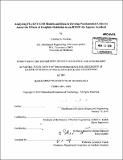Analyzing FLUENT CFD models and data to develop fundamental codes to assess the effects of graphite oxidation in an HTGR air ingress accident
Author(s)
Cochran, Caroline A
DownloadFull printable version (13.57Mb)
Other Contributors
Massachusetts Institute of Technology. Dept. of Nuclear Science and Engineering.
Advisor
Andrew C. Kadak.
Terms of use
Metadata
Show full item recordAbstract
The primary product of this thesis is a faster running computer code to model air ingress events in high temperature gas reactors as a potential subroutine for nodal codes such as MELCOR to model air ingress events. Because of limitations found in FLUENT, and the limitations of the data set, a simple model of the effects of graphite oxidation reactions and structures was built in MATLAB code and is described. This code is based on the fundamental understanding of the physical phenomena at work along with common assumptions. The code is subject to typical instabilities inherent in the physical phenomena as well as uncertainties introduced in the numerical methods themselves. Sample results of the code are presented, which show remarkable similarities to the NACOK data considering the simplistic formulas used. The code structure is described in detail. A simplistic MELCOR model is described, which was built to inform the structure of the code, although the source code for MELCOR was not provided to allow integration of the code into MELCOR. As part of the code development process, the previous MIT work to model air ingress experiments were reviewed to understand the reasons for the portions of apparently non-physical results obtained through past FLUENT models. In addition, a 2-D FLUENT model was created to perform transient analysis which was previously limited to steady state conditions due to the longer computational time required for the 3-D modeling. This model was also created in an effort to compare the results of the previous models using porous media assumptions versus explicitly modeled geometry. Finally, the 2-D model showed valuable steady state results in a much shorter time period than the 3-D model.
Description
Thesis (S.M.)--Massachusetts Institute of Technology, Dept. of Nuclear Science and Engineering, 2010. Cataloged from PDF version of thesis. Includes bibliographical references (p. 102-104).
Date issued
2010Department
Massachusetts Institute of Technology. Department of Nuclear Science and EngineeringPublisher
Massachusetts Institute of Technology
Keywords
Nuclear Science and Engineering.